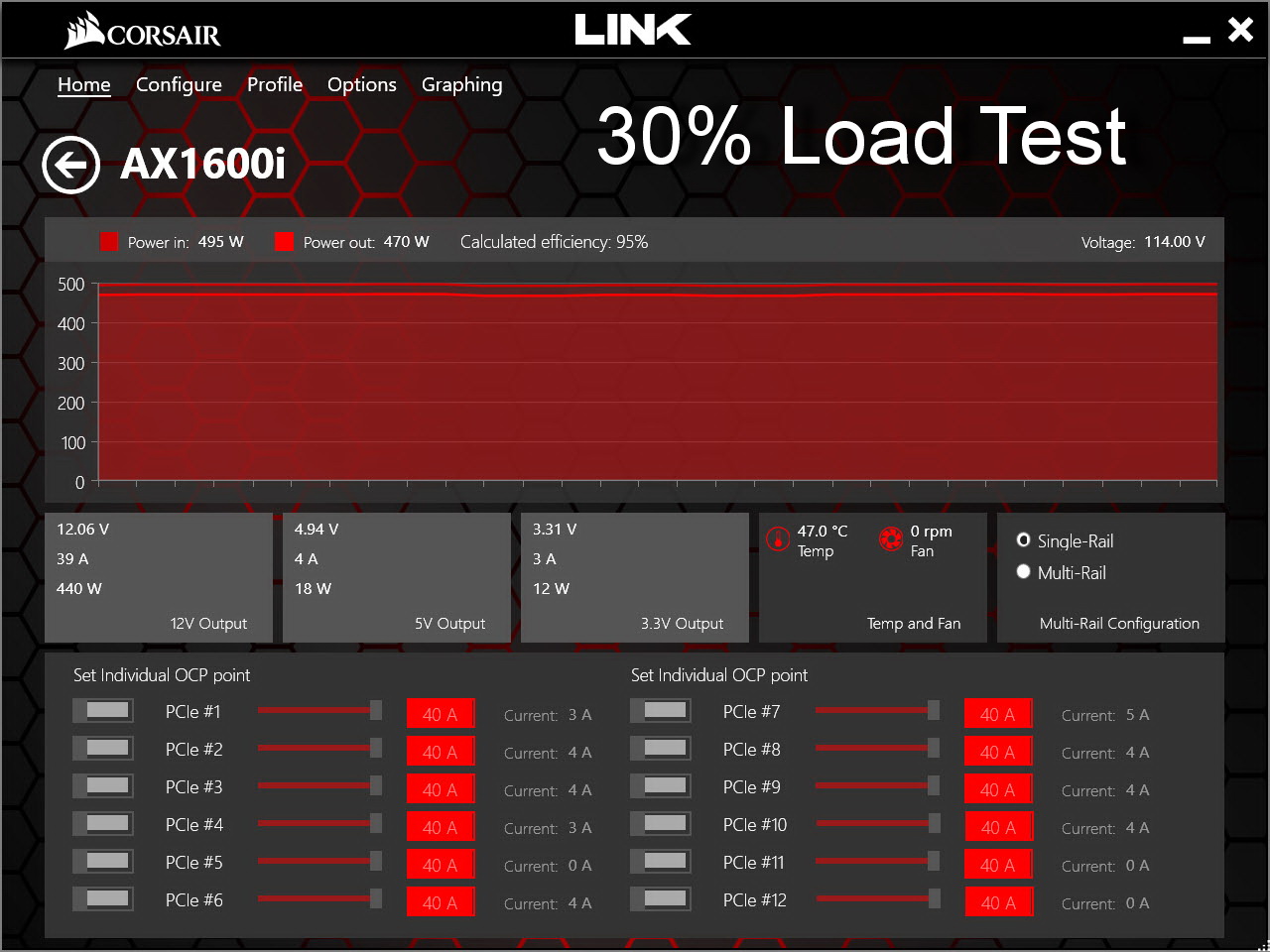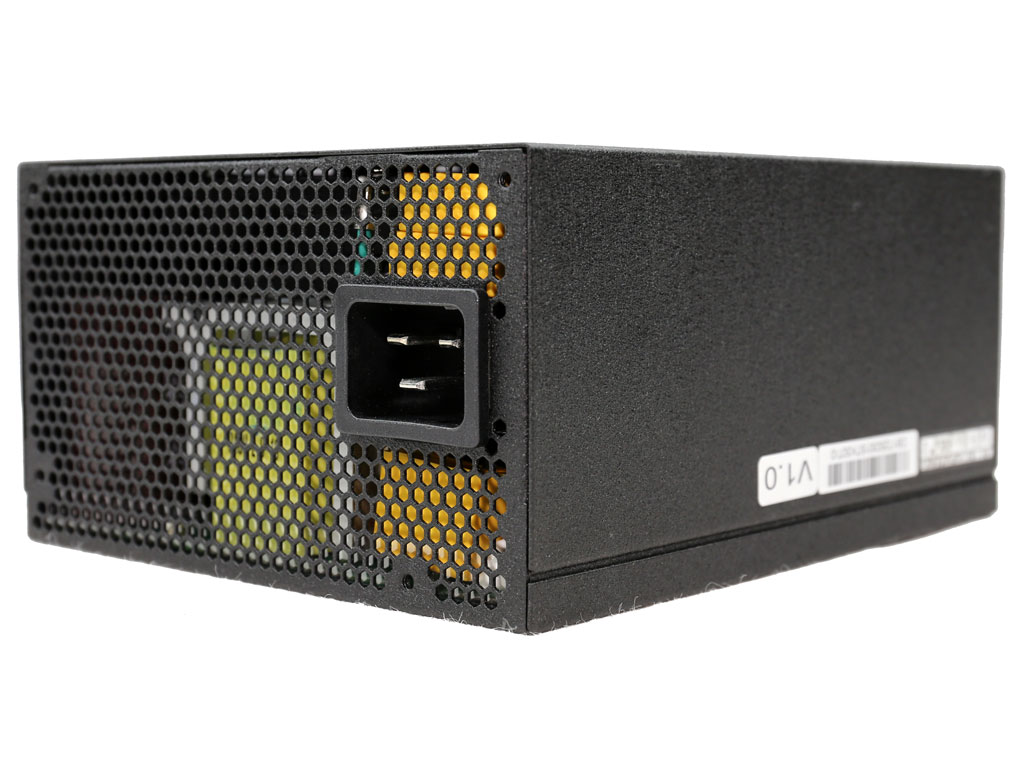Corsair AX1600i PSU Review
Why you can trust Tom's Hardware
Load Regulation, Hold-Up Time & Inrush Current
To learn more about our PSU tests and methodology, please check out How We Test Power Supply Units.
Primary Rails And 5VSB Load Regulation
Load Regulation testing is detailed here.








Hold-Up Time
Our hold-up time tests are described in detail here.







The hold-up time we measure is long, and the power-good signal is accurate. There is nothing more we could ask for.
Inrush Current
For details on our inrush current testing, please click here.


Thanks to an innovative design (and a couple of NTC thermistors), inrush current is kept low in all cases.
Load Regulation And Efficiency Measurements
The first set of tests reveals the stability of the voltage rails and the AX1600i's efficiency. The applied load equals (approximately) 10 to 110 percent of the PSU's maximum load in increments of 10 percentage points.
Get Tom's Hardware's best news and in-depth reviews, straight to your inbox.
We conducted two additional tests. During the first, we stressed the two minor rails (5V and 3.3V) with a high load, while the load at +12V was only 0.1A. This test reveals whether a PSU is compatible with Intel's C6/C7 sleep states or not. In the second test, we determined the maximum load the +12V rail could handle with minimal load on the minor rails.
| Test # | 12V | 5V | 3.3V | 5VSB | DC/AC (Watts) | Efficiency | Fan Speed | PSU Noise | Temps (In/Out) | PF/AC Volts |
|---|---|---|---|---|---|---|---|---|---|---|
| 1 | 11.495A | 2.003A | 1.994A | 1.001A | 159.813 | 92.213% | 0 RPM | <6.0 dB(A) | 42.57°C | 0.957 |
| 12.026V | 4.992V | 3.305V | 4.980V | 173.309 | 38.28°C | 115.10V | ||||
| 2 | 24.021A | 3.001A | 2.994A | 1.206A | 319.745 | 94.148% | 0 RPM | <6.0 dB(A) | 42.93°C | 0.988 |
| 12.026V | 4.990V | 3.304V | 4.975V | 339.619 | 38.50°C | 115.11V | ||||
| 3 | 36.896A | 3.509A | 3.509A | 1.406A | 479.758 | 94.364% | 0 RPM | <6.0 dB(A) | 43.37°C | 0.995 |
| 12.025V | 4.989V | 3.302V | 4.972V | 508.412 | 38.80°C | 115.11V | ||||
| 4 | 49.765A | 4.012A | 3.996A | 1.610A | 639.571 | 94.017% | 0 RPM | <6.0 dB(A) | 44.79°C | 0.997 |
| 12.024V | 4.988V | 3.299V | 4.970V | 680.275 | 39.97°C | 115.10V | ||||
| 5 | 62.290A | 5.011A | 5.002A | 1.811A | 799.388 | 93.656% | 561 RPM | 8.5 dB(A) | 40.17°C | 0.998 |
| 12.023V | 4.986V | 3.298V | 4.966V | 853.534 | 45.47°C | 115.09V | ||||
| 6 | 74.826A | 6.019A | 6.004A | 2.015A | 959.343 | 93.242% | 653 RPM | 13.3 dB(A) | 41.00°C | 0.999 |
| 12.022V | 4.984V | 3.296V | 4.962V | 1028.873 | 46.47°C | 115.58V | ||||
| 7 | 87.360A | 7.021A | 7.012A | 2.215A | 1119.213 | 92.660% | 739 RPM | 17.0 dB(A) | 42.56°C | 0.998 |
| 12.021V | 4.983V | 3.293V | 4.958V | 1207.876 | 48.34°C | 115.38V | ||||
| 8 | 99.902A | 8.035A | 8.016A | 2.421A | 1279.235 | 91.933% | 861 RPM | 21.5 dB(A) | 44.32°C | 0.998 |
| 12.020V | 4.981V | 3.293V | 4.954V | 1391.489 | 50.41°C | 115.34V | ||||
| 9 | 112.869A | 8.538A | 8.540A | 2.421A | 1439.267 | 91.217% | 1490 RPM | 37.8 dB(A) | 45.22°C | 0.999 |
| 12.020V | 4.978V | 3.289V | 4.953V | 1577.850 | 51.93°C | 115.11V | ||||
| 10 | 125.387A | 9.054A | 9.037A | 3.545A | 1599.139 | 90.471% | 1796 RPM | 42.5 dB(A) | 46.86°C | 0.999 |
| 12.018V | 4.975V | 3.286V | 4.936V | 1767.580 | 53.85°C | 115.15V | ||||
| 11 | 138.709A | 9.056A | 9.043A | 3.545A | 1759.090 | 89.717% | 1956 RPM | 45.4 dB(A) | 48.25°C | 0.996 |
| 12.017V | 4.973V | 3.284V | 4.934V | 1960.715 | 55.66°C | 115.15V | ||||
| CL1 | 0.098A | 22.032A | 19.997A | 0.005A | 177.929 | 88.526% | 819 RPM | 19.2 dB(A) | 44.53°C | 0.969 |
| 12.023V | 5.007V | 3.321V | 5.030V | 200.991 | 48.75°C | 115.18V | ||||
| CL2 | 133.259A | 1.003A | 1.003A | 1.002A | 1615.164 | 90.736% | 1784 RPM | 42.5 dB(A) | 47.11°C | 0.999 |
| 12.021V | 4.977V | 3.281V | 4.964V | 1780.064 | 52.48°C | 115.12V |
Let's start with those amazing efficiency numbers. The only test where this PSU drops below the 80 PLUS Titanium's requirements is the 50% load one. The gap is pretty small though, and we test at much higher ambient temperatures than 80 PLUS. Efficiency under full load is perhaps the most impressive data point here: Corsair achieves close to 90.5% efficiency at 47°C with a 1600W load! High efficiency translates into lower energy losses, so the AX1600i's fan doesn't have to cope with taxing thermal loads. Naturally, this helps keep output noise down. It's only during the full and 110% load tests that the fan exceeds 40 dB(A). Corsair built a PSU with monstrous capacity and top performance, then granted it quiet operation.
The load regulation on every rail is super-tight, with the +12V rail steady at its nominal voltage throughout our tests. This is enabled by the use of digital control, which reacts faster than an analog circuit, is more accurate, and can weigh a lot more variables at a time. The minor rails also feature tight load regulation. However, the old AX1500i still fares better in a direct comparison. Corsair's AX1600i does register a clear victory with its 5VSB rail, though.
Corsair Link Screenshots
You will find several screenshots of the Corsair Link software below, which we took during our test sessions.













MORE: Best Power Supplies
MORE: How We Test Power Supplies
MORE: All Power Supply Content
Current page: Load Regulation, Hold-Up Time & Inrush Current
Prev Page Teardown & Component Analysis Next Page Efficiency, Temperature & Noise
Aris Mpitziopoulos is a contributing editor at Tom's Hardware, covering PSUs.
-
Quaddro all of we need is 500w class digital titanium++ psu with this advance technology..Reply
Well, pc is much more efficient right now..
I wonder how many people will use it anyway... -
Aris_Mp Videos working fine here.Reply
PCs are more efficient, however graphics cards once pushed are not and many users tend to overclock their GPUs. Moreover, those units are intended for multi-GPU systems. -
SoerenHedemand Do you do you fan and noise measurements with 110V or 220V? That should make a difference in this case at least.Reply -
Aris_Mp Reply20574970 said:Do you do you fan and noise measurements with 110V or 220V? That should make a difference in this case at least.
115V but I also take noise measurements with 230V because of Cybenetics.
115V: 23.25 dB(A)
230V: 23.29 dB(A)
-
SoerenHedemand Specifically at what point does it change from passive to active cooling using either 110V or 220V?Reply -
ptlin.ece90g Primary DSC should be NXP Freescale MC56F8236Reply
Secondary DSC is Texas Instruments UCD3138064A


